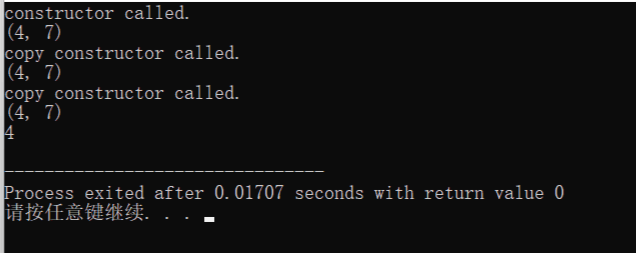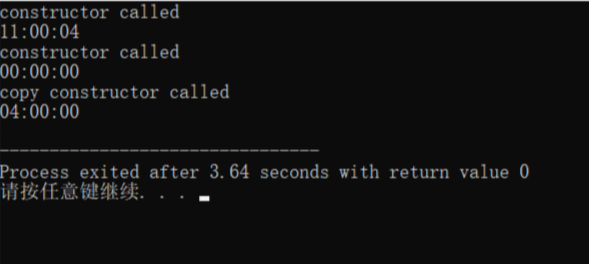实验任务2
#include <iostream>
#include <vector>
using std::cout;
using std::endl;
class Point {
public:
Point(int x0 = 0, int y0 = 0);
Point(const Point&p );
~Point() = default;
int get_x() const { return x; }
int get_y() const { return y; }
void show() const;
private:
int x, y;
};
Point::Point(int x0, int y0): x{x0}, y{y0}{
cout << "constructor called." << endl;
}
Point::Point(const Point& p): x{p.x}, y{p.y} {
cout << "copy constructor called." << endl;
}
void Point::show() const {
cout << "(" << x << ", "
<< y << ")" << endl;
}
int main() {
Point p1(4, 7);
p1.show();
Point p2 = p1;
p2.show();
Point p3{p2};
p3.show();
cout << p3.get_x() << endl;
}
![]()
实验任务3
#include <iostream>
#include <iomanip>
using std::cout;
using std::endl;
class Clock {
public:
Clock(int h = 0, int m = 0, int s = 0);
Clock(const Clock& t);
~Clock() = default;
void set_time(int h, int m = 0, int s = 0);
void show_time() const;
private:
int hour, minute, second;
};
Clock::Clock(int h, int m, int s): hour{h}, minute{m}, second{s} {
cout << "constructor called" << endl;
}
Clock::Clock(const Clock& t): hour{t.hour}, minute{t.minute},
second{t.second} {
cout << "copy constructor called" << endl;
}
void Clock::set_time(int h, int m, int s) {
hour = h;
minute = m;
second = s;
}
void Clock::show_time() const {
using std::setw;
using std::setfill;
cout << setfill('0') << setw(2) << hour << ":";
cout << setw(2) << minute << ":";
cout << setw(2) << second << endl;
}
Clock reset() {
return Clock(0, 0, 0);
}
int main()
{
Clock c1(11, 0, 4);
c1.show_time();
c1 = reset();
c1.show_time();
Clock c2(c1);
c2.set_time(4);
c2.show_time();
}
![]()
实验任务4
#include<iostream>
class X
{
public:
X();
~X();
X(int m);
X(const X& obj);
X(X&& obj) noexcept;
void show() const;
private:
int data;
};
X::X(): data{42}
{
std::cout<<"default constructor called.\n";
}
X::~X()
{
std::cout<<"destructor called.\n";
}
X::X(int m):data{m}
{
std::cout<<"constructor called.\n";
}
X::X(const X& obj): data{obj.data}
{
std::cout<<"copy constructor called.\n";
}
X::X(X&& obj) noexcept: data{obj.data}
{
std::cout<<"move constructor called.\n";
}
void X::show() const
{
std::cout<<data<<std::endl;
}
int main()
{
X x1;
x1.show();
X x2{2049};
x2.show();
X x3{x1};
x3.show();
X x4{std::move(x2)};
x4.show();
}
![]()
47.48行,默认构造函数X()被调用;
50.51行,构造函数X(int m)被调用;
53.54行,复制构造函数X(const X& obj)被调用;
56.57行,移动构造函数X(X&& obj) noexcept被调用。
在对象生命周期结束时,析构函数被调用,跟构造函数的调用顺序相反。
实验任务5
#include <iostream>
#include <iomanip>
using namespace std;
class Rectangle
{
public:
Rectangle(float l = 2.0,float w = 1.0) : length{l},width{w} {}
Rectangle(const Rectangle &obj):
length{obj.length},width{obj.width}{}
~Rectangle()=default;
float len() const {return length;}
float wide() const {return width;}
float area() const {return length*width;}
float circumference() const {return 2*(length+width);}
void resize(int times);
void resize(int l_times,int w_times);
private :
float length,width;
};
void Rectangle::resize(int times)
{
length *= times;
width *= times;
}
void Rectangle::resize(int l_times,int w_times)
{
length*=l_times;
width*=w_times;
}
void output(const Rectangle &rect)
{
using namespace std;
cout<<"矩阵信息:\n";
cout<<std::left<<setw(7)<<"长:"<<std::right<<
fixed<<setprecision(2)<<setw(5)<<rect.len()<<endl;
cout<<std::left<<setw(7)<<"宽:"<<std::right<<
fixed<<setprecision(2)<<setw(5)<<rect.wide()<<endl;
cout<<std::left<<setw(7)<<"面积:"<<std::right<<
fixed<<setprecision(2)<<setw(5)<<rect.area()<<endl;
cout<<std::left<<setw(7)<<"周长:"<<std::right<<
fixed<<setprecision(2)<<setw(5)<<rect.circumference()<<endl;
cout<<endl;
}
int main() {
Rectangle rect1;
output(rect1);
Rectangle rect2(10, 5);
output(rect2);
Rectangle rect3(rect1);
rect3.resize(2);
output(rect3);
rect3.resize(5, 2);
output(rect3);
}
![]()










 浙公网安备 33010602011771号
浙公网安备 33010602011771号